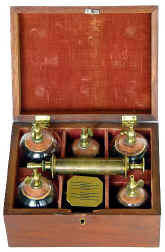
MEDICAL ANTIQUES ARCHIVES
All pictures and text on this site are copyrighted ©1982-2025 Alex Peck. All rights reserved.
PAGE 55
________________________________
A 19th century antique bloodletting cupping set with mahogany fitted-case. The outfit is complete and includes a ten-bladed brass scarificator, five glass cups that are fitted with brass stopcock valves, and a brass pump used to create a vacuum within the cups. A valved-cupping set, such as this example, gave the operator greater control over the vacuum within the cups, which actually drew the blood from the scarified skin, when compared to cups that had to be heated with a flame. The identical bleeding set is described and pictured in the 1860 catalogue of the surgical instrument maker Snowden & Brother, Philadelphia.
_______________________________________
A c. 1890 antique monaural stethoscope that folds flat for ease of carrying. This example is somewhat unusual in that one has to lift the stem in order to disengage the ball-in-socket lock and fold the instrument.
__________________________________________
An exceedingly rare Civil War period antique chloroform tin with the label of the Georgetown, D.C., druggist R.S.T. Cissel. The use of metal for the container indicates a military use was intended, as glass, though cheaper to make, was heavier and easily broken. The Cissel company was previously unknown to this dealer. Dr. Cissel's drug store is listed in an 1854 Georgetown directory as located at the corner of Congress and Bridge. The Georgetown directory of 1874 gives no mention. This tin is an early and important artifact of American anesthesiology.
________________________________________
A rare c. 1790s Dubois obstetrical forceps. See See Das, p. 238.
______________________________________
A nicely turned antique monaural stethoscope with the maker stamp: ALLEN & HANBURYS / LONDON. This is known as Fergusson's stethoscope.
_____________________________________________
A superb Mexican War to early Civil War set of regulation U. S. Army Medical Staff full dress epaulettes. The medical branch insignia of old English M.S. letters and the framing wreath are embroidered directly upon the field, a more expensive option than the more common branch insignia upon a pin-fastened embroidered cushion. The rank insignia are pinned to the field, and the two bars of a second lieutenant indicate that the epaulettes belonged to an assistant surgeon. (Note that one bar is missing.) The fringe is fixed to a backing in the 1840s manner. Each fastening brass strap is stamped: HORSTMANN & SONS / PHILADELPHIA. Horstmann first went by this name ca. 1843 and was a leading military outfitter during the nineteenth century. The original japanned-tin case is stenciled with stars and two eagles.
_____________________________________________
A Civil War period Ames Model 1840 Medical Staff sword.
______________________________________________________
A c. 1860 antique obstetrical crotchet and hook by Weiss, London.
____________________________________________
A c. 1900 two-handled antique chainsaw for exsectioning and resectioning bone. The handles bear the logo of the surgical instrument maker Kny-Scheerer. By the early 1900s the chain saw was largely replaced by the more efficient and easier to maintain Gigli wire orthopedic saw.
_________________________________
A c. 1880 antique monaural Robert's stethoscope. The instrument is made from two pieces that can be taken-down for ease of carrying.
_________________________________________
A Civil War antique field tourniquet in its original paper wrapping with ink inscription: 1 Field Tourniquet / U.S.A. / Hospt. Dept. The wax seals on the paper have been broken, and the small Hospital Department tourniquet can be removed. The brass frame of the buckle is stamped: Tiemann. The strap has never been unwound and the original inner wax paper cover remains. This is an example of the sort of individual tourniquet that is contained in the one dozen tourniquet package found on page 24., item 184.
__________________________________
A c. 1900 ceramic antique phrenology bust by Lorenzo N. Fowler, Ludgate Circus, London. The condition, transfer graphics, and blue borders are very fine. This is an iconic example of an antique Fowler phrenology head.
__________________________________
A c. 1860 antique enema set with plaque affixed to the brass pump that states: READ'S NEW PATENT // 35 REGENT CIRCUS // LONDON. John Read (1760-1847) was the inventor. The set is complete and includes two pewter nozzles.
____________________________________________
A c. 1840 obstetric vectis (lever) with horn handle. The slightly curved blade of this antique obstetrical instrument is fenestrated. See Hibbard, p. 207, and fig. 16.19.
______________________________________________
Page 55
1. 2. 3. 4. 5. 6. 7. 8. 9. 10. 11. 12. 13. 14. 15. 16. 17. 18. 19. 20. 21. 22. 23. 24. 25. 26. 27. 28. 29. 30. 31. 32. 33. 34. 35. 36. 37. 38. 39. 40. 41. 42. 43. 44. 45. 46. 47. 48. 49. 50. 51. 52. 53. 54. 55. 56. 57. 58. 59. 60. 61. 62. 63. 64. 65.
Home Page Collecting Alerts Reference Books Wants